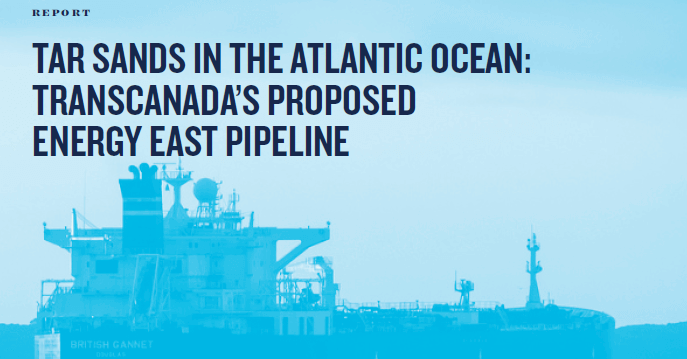
Canadian Groups Call on Federal Government to Reject Pipelines,
As New U.S.Led Campaign Calls for National Tar Sands Dilbit Tanker Ban
July 26, 2016, Saint John—A new report released today by the US – based Natural Resources Defense Council (NRDC), in partnership with the Conservation Council of New Brunswick and other numerous Canadian and U.S. groups, shows the proposed Energy East pipeline would drive a 300 to 500 per cent increase in crude tanker traffic down the Atlantic coast from Saint John, New Brunswick to the U.S. Gulf Coast— industry’s preferred refinery market for processing tar sands bitumen. The report, “Tar Sands in the Atlantic: TransCanada’s Proposed Energy East Pipeline,” shows the addition of almost 300 supertankers would pose a massive threat—in the form of deafening ocean noise, heightened risks of major oil spills, and the introduction of invasive species—to marine mammals like the endangered North Atlantic right whale, the Bay of Fundy’s lucrative lobster fishery, and other iconic regions like the Florida Keys.
“The Energy East pipeline and tanker proposal is too risky for our communities, water and wildlife,” said Keith Brooks, Campaigns Director at Environmental Defence. “The federal government says tar sands oil doesn’t belong in the Great Bear Rainforest or the North Coast of BC. The boreal forest of eastern Canada and places like the Bay of Fundy on the Atlantic coast are no different.”
NRDC, which was instrumental in the campaign to stop the Keystone XL pipeline, also announced today a new campaign calling for a national moratorium on tankers carrying tar sands dilbit in U.S waters, which would apply to the Atlantic and Pacific oceans. In just a week, a petition to the White House has garnered more than 80,000 signatories.
“Energy East represents a set of extraordinary threats to the U.S. East Coast,” said Anthony Swift, Director of NRDC’s Canada Project. “It would be irresponsible for regulators to turn a blind eye to what could happen with Energy East’s oil once it’s loaded onto tankers bound for the Gulf Coast.”
“In the face of these threats—which we know from the National Academy of Sciences represent nearly impossible challenges for industry and spill responders to address—we believe there’s a pressing need for a moratorium on tar sands tankers and barges in U.S. waters,” added Swift.
In the U.S., the Coast Guard and the Environmental Protection Agency have the authority to approve or reject vessel and facility spill response plans. According to the NRDC, given a lack of technology designed for confronting submerged and sunken oil, no response plan can adequately clean up diluted bitumen. Unlike conventional crude, large portions of diluted bitumen can be expected to sink if
spilled in water, according to a 2016 study by the National Academy of Sciences (NAS). The NAS also found that current regulations and spill response techniques are incapable of managing the unique behavior and higher risks of tar sands diluted bitumen spill in water.
“To be at all credible, the National Energy Board must give the NAS study a central role in its review of Energy East,” said Matt Abbott of the Conservation Council of New Brunswick, who added the NEB has denied the opportunity for consultation on the tanker issue in Nova Scotia, which, along with New Brunswick, would be most directly impacted by tar sands tanker traffic.
Meanwhile, in British Columbia the NEB refused to consider the same NAS study in its Kinder Morgan pipeline analysis.
“We already have tankers loaded with diluted bitumen plying the West Coast, threatening communities on both sides of the border,” said Will Horter, strategy director at Dogwood Initiative. “Now Kinder Morgan is pushing ahead with plans for a seven-fold expansion in tanker traffic, with no ability to clean up submerged oil.” Today also marks the six-year anniversary of the Kalamazoo, Michigan spill, where
4.2 million litres of tar sands dilbit crude spilled into the river after a rupture in the Enbridge pipeline. The five year spill response effort cost more than $1 billion USD and bitumen residues remain in place on the river bottom despite extensive dredging.
Partners of NRDC’s report — which is available online here —include 350.org, 350Maine, 350 Massachusetts for a Better Future, Conservation Council of New Brunswick, Ecology Action Centre, Environmental Defence, Environment Maine, Equiterre, Friends of the Earth, Greenpeace, Natural Resources Council of Maine, Oil Change International, and Sierra Club.
Read the complete Tanker report, here.
-30-
To learn more about an alternative vision for New Brunswick that focuses on renewable energy investments as apposed to the Energy East pipeline, check out the Conservation Council’s Bold, Made-in-New Brunswick Plan to Address Climate Change.
For more on the Energy East Pipeline, check out:
- CCNB’s Executive Director Lois Corbett on major oil pipeline break in Saskatchewan
- Fundy Baykeeper on changes that double Energy East-related tanker traffic in Bay of Fundy
- Fundy Baykeeper talks Energy East risks on CBC’s Maritime Connection
- Energy East pipeline too risky, says Montreal Mayor
For more information on the , please contact:
- Anthony Swift, Canada Project Director, NRDC, 202-513-6276
- Tim Ehlich, Communications Manager, Environmental Defence, 647-468-3641
- Matthew Abbott, Director of Marine Conservation, Conservation Council of New Brunswick, 506-321-0429
- Will Horter, Strategy Director, Dogwood Initiative, 250-418-1672
- Stephen Thomas, Energy Campaign Coordinator, Ecology Action Centre, 902-4417136
